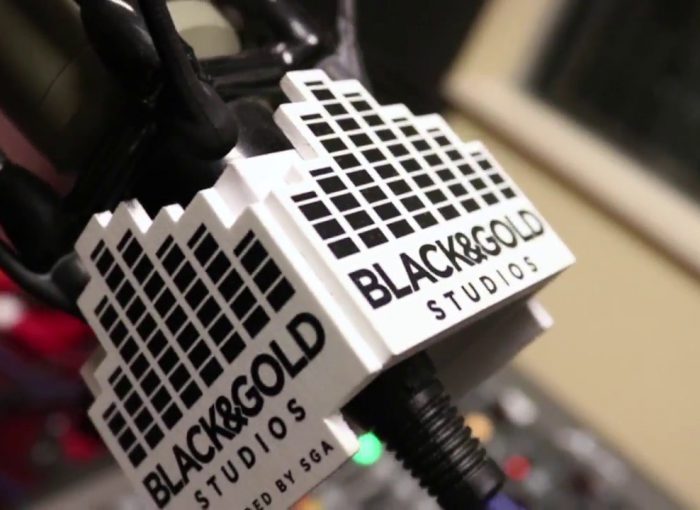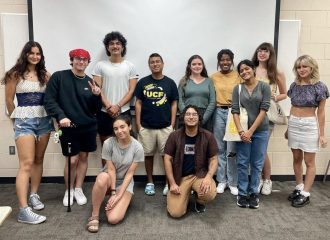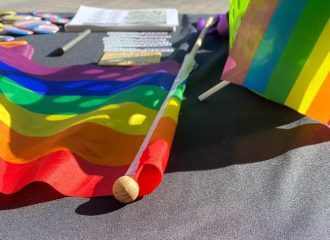by Keausha Bradley-Macklin
As a junior at UCF majoring in radio and television, I’ve discovered there are many resources at UCF that aid those in my major as well as other creative students who might want to develop podcasts or other radio-related projects. These resources are available on campus for UCF students and are completely free! Many students that take an interest in radio or TV production can easily design and produce their own podcast or radio show for an inexpensive price. Whether using school assets or doing it on their own, students may easily construct their own personal podcast without breaking the bank.
If you are a UCF student wanting to start your own podcast at a low-cost, then these UCF resources are completely free and available to you.
Where can I start my podcast?

What equipment do I need?
Inside Black and Gold Studios there is an electronic audio mix board that has preset settings based on which microphones you choose to use, making it an easy tool for beginners. There is a 5-mic option which is great for group podcaster layouts with your friends, and of course, there is a mic for solo podcasters. There is also a desktop computer with Adobe Cloud.
What software do I need?
At Black and Gold Studios, they have a computer desktop with Adobe Audition to record. In Tech Commons 2, there is a computer lab complete with the Adobe Cloud, which includes Adobe Audition. To learn how to use this software, all you need is time, patience, and YouTube.
What hosting platform should I use?
Anchor FM is one of the top completely free hosting services. The app gives you the ability to record, edit, and make guest calls. If you want to use a microphone, then you will need to upload your files to their website. The biggest drawback for Anchor FM is the fact you don’t fully own your podcast.
If you prefer to start your podcast with your own equipment and space but still want low-expense options, the following resources are relatively cheap and easily accessible to you as well.
Where can I start my podcast?
Believe it or not, you can set up your podcast in your room. There are even some podcasters that record in their closets. Record in a place that is quiet and comfortable; the room needs to be a place that doesn’t echo or let sound bounce off the walls too much. The advantages of podcasting in your own room would be customization, comfort, and accessibility. The disadvantages are that your room might be too small for group settings, and people outside your room could interrupt or be heard in the recording.
What equipment do I need?
The first thing you’ll need is a way to record your voice. You can use your phone or a microphone that suits your budget and needs. There are several different types of microphones that can be used. The best thing to do as a beginner is research: there are thousands of different mics and mic set-ups. You can start off cheap and slowly upgrade your equipment based on your needs and the type of podcast you have.
USB Microphones are good, cheap options for beginners. The Blue Snowball is best for solo podcasters, while the Blue Yeti can be used for both solo and group recording depending on the settings you use. However, for group settings, it is ideal that each speaker has a separate microphone. Here are a few I recommend:
Condenser and dynamic microphones are better quality options. On the cheaper end, they can run anywhere from $30 to $100. It’s worth pointing out that Amazon has a lot of bundles for these microphones that come with almost everything you need. A high-quality bundle would be the Focusrite Scarlett 2i2 Studio (2nd Gen) USB Audio Interface and Recording. If you’re having a two-podcaster setup, I would recommend purchasing another mic along with the bundle. Lastly, you’ll need decent headphones to listen to and edit audio, along with a laptop or desktop computer.
What software do I need?
To edit your audio, a popular free option is a software program called Audacity. Again, to learn this software all you need is time, patience, and YouTube.
What hosting platform should I use?
Anchor FM is still a good choice; however, if you want to own your podcast, Podbean’s $15-a-month option is great because it has unlimited storage/bandwidths, which no other paid podcasting service has.
To get a closer look at what goes into starting your own podcast, I sat down with the host of the self-made podcast, “Sebypodcast.” Sebastian Bland, a UCF student, who conducts a weekly podcast discussing sports-related topics, events, and interviews. Along with his podcast, he also has his own website and blog featuring the latest sports events. He’s also been able to acquire a massive following, with a total of 5,000 followers on YouTube and 11.5K followers on Instagram.
Sebastian started his “Sebypodcast” in 2016, taking almost four years to acquire his current popularity and following. When asked what advice he’d give to students wanting to start their own podcast, he says, “I would say stay persistent; that’s the key. Try to find your niche; when you start a podcast you must able to put the work in. There’s a lot of technical things—it’s much more than just talking on a mic. Find out your listeners’ demographics and target it to your audience”. His choice of place to record his podcast is currently inside WNSC in Nicholson, but he will soon be recording in TATV. He started off recording in his room and states, “Once I moved to the studio, my podcast started to take off. There’s a control panel with mics.”
When it comes to uploading his podcast, he chooses to use Anchor to distribute it on different platforms such as iTunes, Spotify, and Google. “I like Anchor because it’s easy to use and simple, and you can even record on Anchor. Which is great when I’m not able to go to the studio; however, it’s much better to use your own mics.” Promotion is imperative when creating a podcast because you need as many people as possible to tune in to make it successful. Promotion includes posting your podcast on social media handles such as YouTube and Instagram, or creating a website or blog specifically tailored to your podcast. Sebastian uses YouTube for interviews with athletes and reporters for special segments of his podcast. “Twitter can be a professional outlet or just a way to connect with listeners and sports analysts. I didn’t know the importance of a website until my manager told me that I can put everything on my website, so listeners have everything you need at once. There so much you can add, like listeners giving feedback; customization is unlimited.”
For those of you wanting to know if money can be earned from posting your podcast on certain platforms, the answer is absolutely! Monetization is an option for YouTube where you can get money from the views received by fans. Sebastian’s podcast is currently monetized on YouTube, and he also has sponsors such as Geico and Revamp Barbershop that aid in his podcast’s success. “We make money off of Anchor based off how many people are listening. The most I’ve had was 3,000 listeners; each podcast ranges. If you really want to make a podcast and money, audio is the way to go. Video is going to take you longer and make less money.”
Your podcast can have different formats and can include as many or as little people as you want. It’s better to have multiple people when doing a podcast–your audience’s attention span might be low–so it’s a refresher to hear the voices and opinions of different people. When trying to record a podcast with people that aren’t in the same room, for interviews or with guest speakers, Sebastian’s choice is using a mixer in the studio while on the phone with the guest. “Or we’ll use Anchor, which is another feature it has. I prefer Anchor because I can edit right then and there.”. To conclude our interview, I asked him what the hardest thing was when podcasting as a student. He replied, “The hardest thing is being consistent, the technical aspect, having to invest in your self-buying mics, and editing. Finding a consistent audio engineer is key. At first, I started editing it myself, then eventually was able to pay someone.” These tools and techniques have helped Sebastian’s “Sebypodcast” become successful while still being affordable.
If you’re having any doubts about creating your own podcast because of low finances or lack of experience, there is no need to worry. You can have a successful podcast for little to no cost whether you’re creating it in your room or using school resources. Remember that ANYONE can create a podcast!
For more information on how to use Black and Gold Studios, check out this video:




